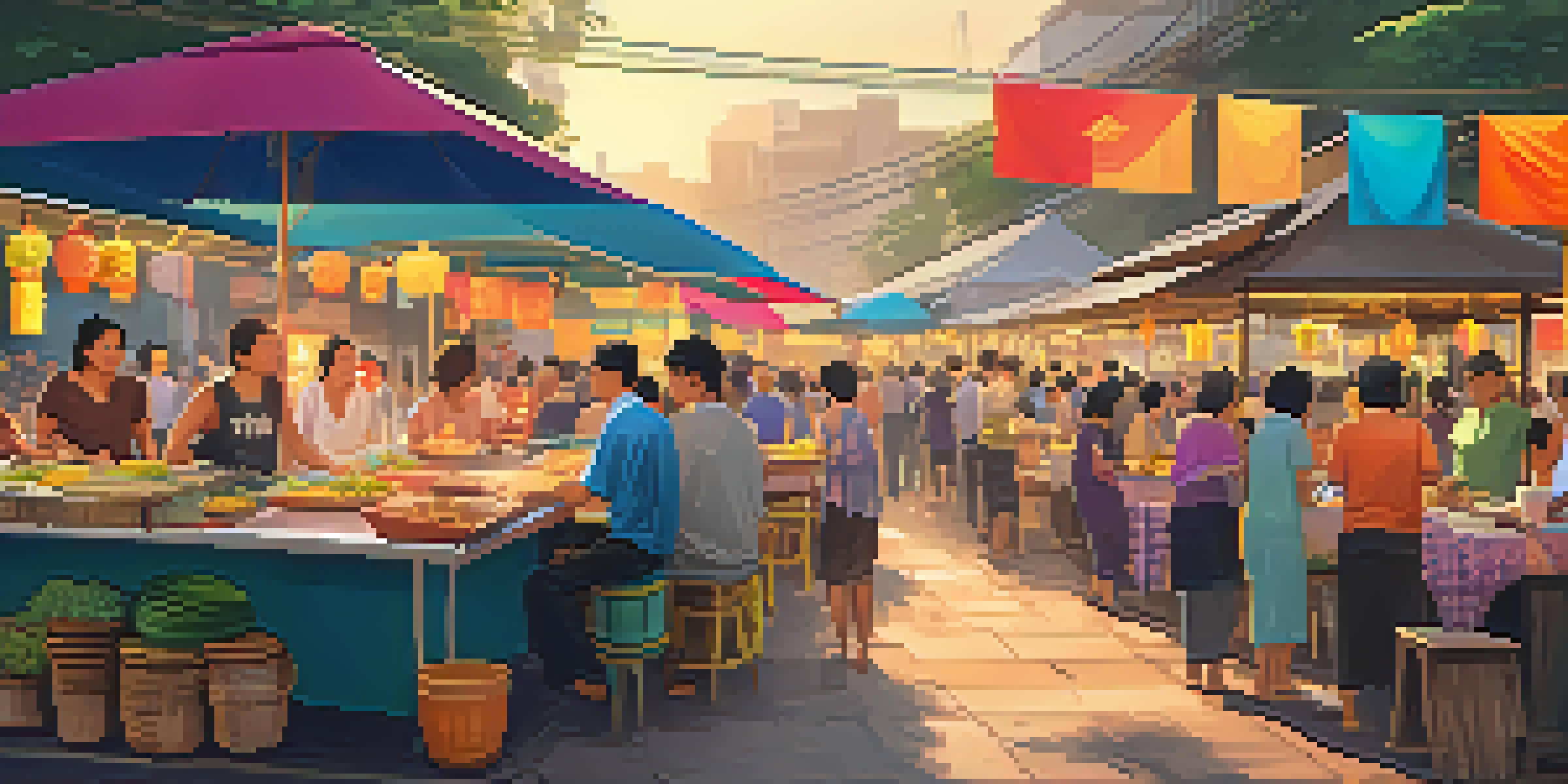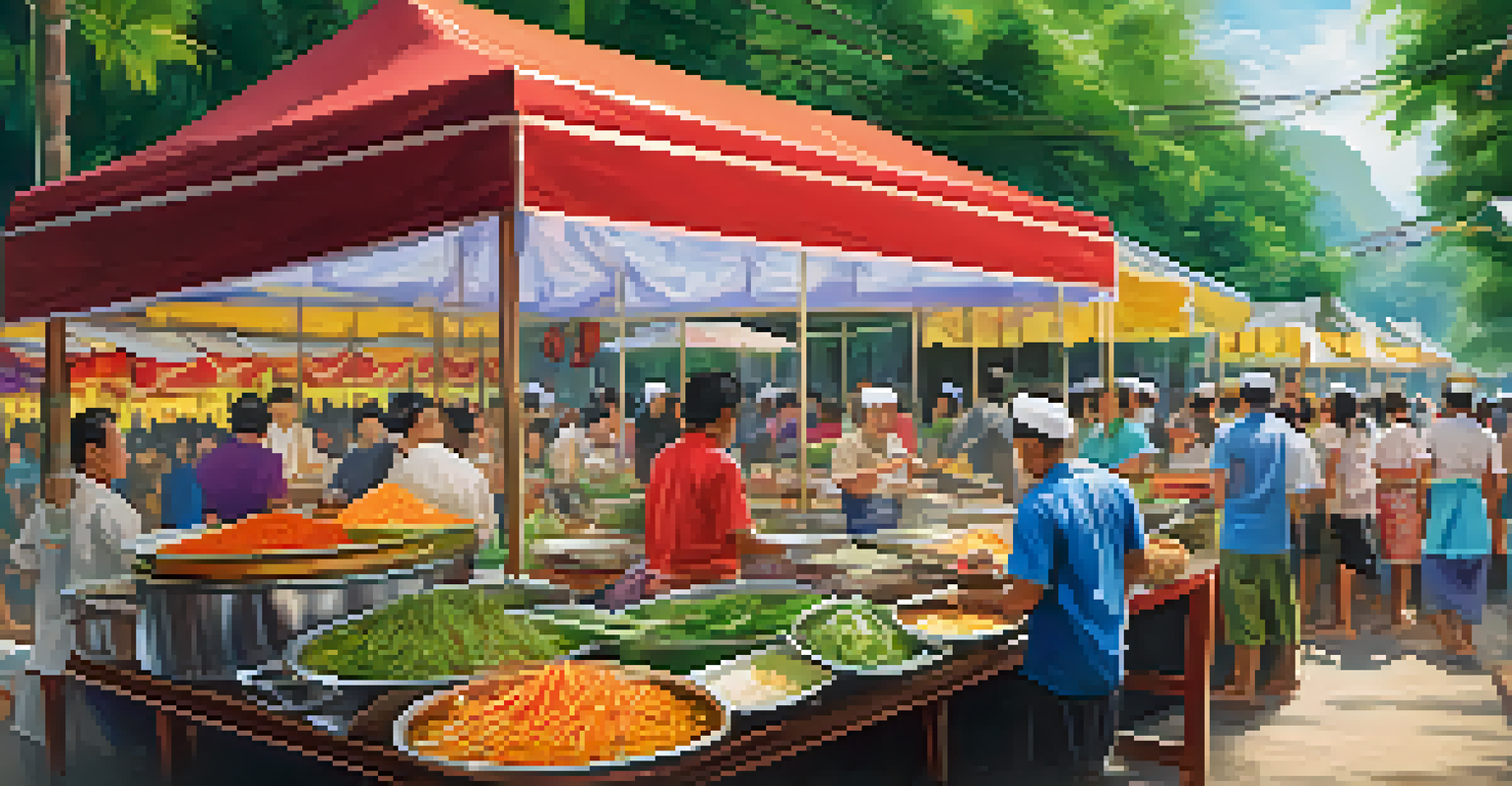A Culinary Journey Through Thailand's Iconic Regional Dishes

Discovering the Flavors of Northern Thailand
Northern Thailand is known for its unique flavors and ingredients, setting it apart from other regions. Dishes like Khao Soi, a creamy coconut curry noodle soup, showcase the area's love for bold spices and fresh herbs. The use of local ingredients, such as turmeric and galangal, adds depth to the flavors and highlights the region's agricultural bounty.
Food brings us together, and it has the power to create bonds and experiences that last a lifetime.
Another standout dish is Nam Prik Ong, a spicy tomato and minced pork dip served with fresh vegetables. This dish is not just a meal but a reflection of the communal dining culture in the North, where sharing food brings people closer together. The vibrant colors and rich aromas create an inviting atmosphere, encouraging everyone to dig in.
Exploring Northern Thailand's cuisine is like taking a culinary adventure. Each bite tells a story of tradition, history, and the land's natural beauty. It's a region where flavors dance together, leaving a lasting impression on anyone who visits.
The Spicy Delights of Northeastern Thailand
Northeastern Thailand, or Isaan, is famous for its bold and spicy dishes, often featuring fragrant herbs and sticky rice. One of the most popular dishes is Som Tum, a green papaya salad that balances heat, tang, and sweetness, making it a favorite among locals and tourists alike. The freshness of the ingredients is key, and each preparation can vary from vendor to vendor.

Isaan cuisine also includes Larb, a minced meat salad mixed with lime juice, fish sauce, and roasted rice powder. This dish embodies the essence of Thai cooking, where balance and harmony of flavors are paramount. Often enjoyed with a side of sticky rice, Larb is a staple at many gatherings and celebrations.
Diverse Flavors Across Thailand
Each region of Thailand boasts unique flavors and ingredients that reflect its culture and agricultural bounty.
Dining in Northeastern Thailand is an experience filled with vibrant flavors and lively conversations. The food not only satisfies the palate but also connects people, making every meal a celebration of culture and community.
Exploring Central Thailand's Culinary Traditions
Central Thailand is often regarded as the heart of Thai cuisine, with Bangkok serving as a culinary melting pot. The region is known for its balance of sweet, sour, salty, and bitter flavors, which come together in dishes like Pad Thai. This iconic stir-fried noodle dish, typically made with shrimp or chicken, highlights the region's emphasis on harmony in cooking.
The discovery of a new dish does more for the happiness of mankind than the discovery of a star.
Another signature dish is Tom Yum Goong, a hot and sour soup celebrated for its aromatic broth, made from lemongrass, kaffir lime leaves, and chili. The explosion of flavors in this dish is a testament to the rich culinary heritage of Central Thailand, where each ingredient plays a crucial role in creating a delicious experience.
Eating in Central Thailand feels like being part of a grand feast, where street food stalls and upscale restaurants coexist. The abundance of choices reflects the region's vibrant culture, inviting everyone to explore and indulge in its diverse culinary offerings.
The Coastal Flavors of Southern Thailand
Southern Thailand is a treasure trove of seafood and spicy curries, influenced by its coastal geography. One must-try dish is Massaman Curry, a rich and creamy blend of spices, coconut milk, and meat, often served with potatoes. This dish showcases the region's Muslim influences and the use of local ingredients, creating a unique flavor profile that sets it apart.
Another highlight is the fresh seafood that the southern coast offers, with dishes like Pla Pao, grilled fish stuffed with herbs and served with a spicy dipping sauce. The freshness of the catch and the simplicity of preparation emphasize the importance of quality ingredients in Southern Thai cuisine.
Street Food as Cultural Experience
Thai street food offers a vibrant culinary adventure, showcasing regional dishes in bustling markets and roadside stalls.
Dining in Southern Thailand is a sensory delight, where the aromas of spices and the sounds of waves combine to create an unforgettable experience. It's a place where food is not just sustenance, but a reflection of the region's culture and lifestyle.
The Influence of Thai Street Food Culture
Thai street food is an integral part of the country's culinary landscape, offering a variety of dishes that reflect regional flavors. From bustling markets to roadside stalls, the vibrant atmosphere is filled with the aromas of grilled meats, fried noodles, and sweet desserts. Street food embodies the spirit of Thai cuisine, where accessibility and flavor go hand in hand.
Dishes like Satay, skewered grilled meat served with a peanut sauce, and Pad See Ew, stir-fried noodles with soy sauce, showcase the bold flavors and quick preparation that street food is known for. These meals are often enjoyed on the go, making them perfect for busy city life while still capturing the essence of Thai cooking.
Experiencing Thai street food is a culinary adventure that allows you to sample a wide variety of flavors in one trip. It's an opportunity to connect with local culture, try new dishes, and savor every bite.
Exploring Regional Ingredients and Their Significance
Each region of Thailand boasts its own unique ingredients that are crucial to its culinary identity. For instance, the use of fresh herbs like cilantro and mint in Central Thailand highlights the region's emphasis on freshness and flavor. These herbs not only enhance dishes but also provide health benefits, making them a staple in Thai cooking.
In the North, ingredients like sticky rice and fermented fish sauce are fundamental to the cuisine, serving as the base for many traditional dishes. The incorporation of local produce, such as the famous Thai chili, adds a distinctive kick that is characteristic of Northern flavors.
Festivals Celebrate Culinary Heritage
Food festivals in Thailand foster community and highlight the importance of sharing meals and local ingredients.
Understanding the significance of these ingredients allows us to appreciate the depth of Thai cuisine. Each dish tells a story of the land, the people, and the traditions that shape the culinary landscape, making every meal a journey through Thailand's rich heritage.
The Role of Festivals in Thai Culinary Traditions
Food festivals in Thailand are vibrant celebrations that showcase the country’s diverse culinary heritage. Events like the Chiang Mai Flower Festival highlight the region’s local ingredients and traditional dishes, bringing together chefs and food enthusiasts alike. These festivals create a sense of community, allowing people to share their passion for food and culture.
During these celebrations, visitors can sample a wide array of dishes, from street food to gourmet creations, all while enjoying live performances and cultural displays. It's an immersive experience that highlights the importance of food in Thai culture, emphasizing the joy of sharing meals with family and friends.

Participating in a food festival in Thailand is a delightful way to explore regional cuisines while connecting with locals. It’s a reminder that food is not just about nourishment but also about building relationships and creating lasting memories.